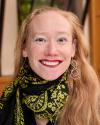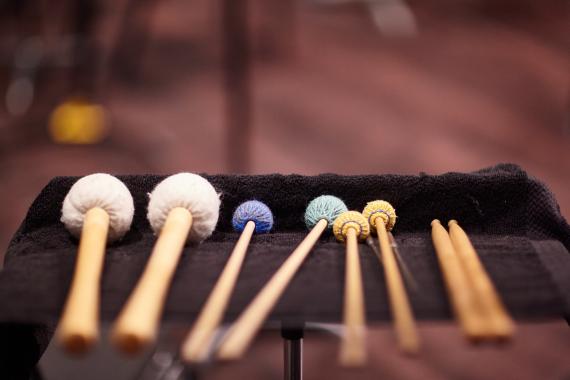The UW Percussion Ensemble (Bonnie Whiting, director) performs music by Caroline Shaw, Elena Rykova, and Qu Xiao-Song, plus open scores by Pauline Oliveros, George Lewis, and Stacey Bowers. Also featured: first-year undergraduates in ragtime arrangements for xylophone and marimba.
Program
University of Washington Percussion Ensemble
Thursday, May 23rd, 7:30 pm, Meany Studio Theatre
Bonnie Whiting, director
Pattern Study no. 2 (1976): Stacey Bowers
Subito Dodo (2017): Elena Rykova
The Well and The Gentle (1983): Pauline Oliveros
Drums of Xi (1991): QU Xiao-Song
-PAUSE (5 min)-
Hemispherectomy (2024): Melissa Wang/Abigail George
Artificial Life 2007, Page 1 (2007): George Lewis
Taxidermy (2012)-: Caroline Shaw
Ragtime Suite (arr. Bob Becker, 1990): George Hamilton Green
Log Cabin Blues (1924): Cyan Duong, xylophone
Rainbow Ripples (1926): Luigi Salvaggio, xylophone
The Whistler (1924): Ivy Moore, xylophone
Triplets (1924): Momoka Fukushima, xylophone
The UW Percussion Ensemble
Ryan Baker, Cyan Duong, Scott Farkas, Momoka Fukushima, Abigail George, Simon Harty, Gabriel Kennedy-Gibbens, Taryn Marks, Rose Martin, Ivy Moore, Grace Rosing, Luigi Salvaggio, Gracia Wang, Melissa Wang, Nat Yamamoto
Acknowledgements
Many thanks to: Rose Martin (our graduate student coach and TA), Kaisho Barnhill (our student worker), the Meany Center staff, the UW School of Music staff, and our Director Joël-François Durand
The University of Washington acknowledges the Coast Salish peoples of this land, the land which touches the shared waters of all tribes and bands within the Suquamish, Tulalip and Muckleshoot nations.
Program Notes
PATTERN STUDY #2 by Stacey Bowers, dedicated to the Blackearth Percussion Group, was written in 1976. Twenty-four patterns are repeated and improvised over a seven-note bass line that is repeated throughout. These patterns can be played in any order, repeated as often as desired, and used as a basis for improvisation. The work can be played by any pitched instruments and often incorporates drums or other rhythm instruments to sustain a pulse. The form emerges from the resultant improvisation.
Elena Rykova wrote SUBITO DODO (2017) for 5 players and prepared table. She writes:
It appeared out of the blue on my street. I was surprised to the extent that I didn’t think to take a photo or video of this bird. The next time we met, on the same street, it was running purposefully as if hunting. I tried to chase it, but he was much quicker than me. Both times, there was no one else around; not even a car- just him and me. The bird was bigger than a duck or any other American bird that may normally roam the streets of Cambridge. I like to think of that bird as a Dodo. This occasion caused me to consider the way in which my imagination affects my perception of reality, blending my thinking with daydreaming, which has made this kind of piece appear. Out of the blue. In my head.
THE WELL AND THE GENTLE (1983), was commissioned by the Relache new music ensemble and is one of the more popular of Oliveros' text-based intuitive pieces. Musicians are given a different scale for each of the two sections with one rhythmic motif for the second section and instructions for musical interaction.
QU Xiao-Song’s DRUMS OF XI was composed for Percussion Group Cincinnati, and is an excerpt of the composer’s larger percussion sextet, Xi. Earlier this month, the group was lucky to have a coaching with percussionist Allen Otte, founding member of PGC.
HEMISPHERECTOMY, co-composed by Abigail George and Melissa Wang for drum set and marimba, explores striking combinations of techniques, such as resonator play on the marimba and rattling chains on drum heads.
Without a notated score, George Lewis’s ARTIFICIAL LIFE (2007) instead comprises a set of instructions for a flexible group of instruments, guiding them through a complex and highly structured, yet in many ways open-ended improvisation: no conductor is required, and many dimensions of the performance, including duration and instrumentation, are up to the performers. Commissioned for the Glasgow Improvisers Orchestra by the Scottish Arts Council, the work may be performed by musicians with any or no experience with musical improvisation.
Why “TAXIDERMY”? I just find the word strangely compelling, and it evokes something grand, awkward, epic, silent, funny, and just a bit creepy — all characteristics of this piece, in a way. The repeated phrase toward the end (“the detail of the pattern is movement”) is a little concept I love trying (and failing) to imagine. It comes from T.S. Eliot’s beautiful and perplexing Burnt Norton (from the Four Quartets), and I’ve used it before in other work — as a kind of whimsical existentialist mantra. –Caroline Shaw
In the mid-1920’s virtuoso xylophone soloist George Hamilton Green created intricate, blisteringly fast “novelty” rags for percussionists to play. A century later, we’re using a set of these pieces (arranged by Bob Becker in the 1990’s) to feature our fantastic first-year percussion students in a rousing concert closer.
Director Biography

Bonnie Whiting (she/her) performs, commissions, and composes new experimental music for percussion. She seeks out projects involving the speaking percussionist, non-traditional notation, improvisation, and interdisciplinary performance. Her debut album, featuring an original solo-simultaneous realization of John Cage's 45' for a speaker and 27'10.554” for a percussionist, was released by Mode Records in April 2017. Her sophomore album Perishable Structures, launched by New Focus Recordings in 2020, places the speaking percussionist in the context of storytelling and features her own music as well as works by Vinko Globokar, Frederic Rzewski, Richard Logan-Greene, and Susan Parenti.
Her recent season highlights include onstage work in the multimedia chamber opera The Ritual of Breath Is the Rite to Resist, featuring productions at Lincoln Center’s Summer for the City, at The Hopkins Center at Dartmouth College, and at Stanford Live; a reprise of composer Wang Lu’s Stages for solo speaking/singing percussionist at New York’s Performance Spaces for the 21st Century (PS21); and four performances of a new concerto written for her by Jonathan Bingham with the National Symphony Orchestra for the family pops series at the Kennedy Center alongside renowned children’s book author Mo Willems. Whiting also creates original, improvised music with clarinetist James Falzone and pianist Lisa Cay Miller; their first album was released on Allos Documents in 2024, and the trio performs this season in Seattle, Vancouver, and Portland.
In 2022 she premiered Through the Eyes(s): an extractable cycle of nine pieces for speaking/singing percussionist collaboratively developed with composer Eliza Brown and ten artists and writers incarcerated at the Indiana Women’s Prison. The project was featured on NPR’s nationally-syndicated Slingshot, and locally via Seattle’s ClassicalKING radio station. Whiting has an ongoing relationship as a soloist with the National Orchestra of Turkmenistan via the U.S. Embassy Cultural Affairs Office, playing concerti in Ashgabat in 2017 and 2018. She performs frequently with percussionist Jennifer Torrence, giving concerts of new experimental work for speaking percussionists throughout Norway and the US. Her collaboration with multimedia artist Afroditi Psarra generated the album <null_abc>, released on the Zero Moon label in 2018, and their project with designer Audrey Desjardins on transcoding data from IoT devices as performance received a 2019/20 Mellon Creative Fellowship. The project was explored in a workshop at the 2020 Transmediale Festival in Berlin, and currently lives as an interactive net art installation. She spent four years performing music for voice and percussion with the Harry Partch Ensemble on the composer’s original instrumentarium while the instruments were in residence at the UW. Whiting has presented solo and small ensemble shows at The Stone in New York, the Brackish Series in Brooklyn, The Lilypad in Boston, The New York City Electroacoustic Music Festival, at Hallwalls in Buffalo, the Tiny Park Gallery in Austin, The Wulf in LA, the Carl Solway Gallery in Cincinnati, The Grove Haus in Indianapolis, on the Wayward Music Series in Seattle, on tour throughout New Zealand, and at colleges and universities around the country.
Whiting is the Co-Artistic Director and core percussionist of the Seattle Modern Orchestra, the Pacific Northwest’s only large ensemble solely dedicated to music of the 20th and 21st Centuries, and she plays vibraphone with the Torch Quartet. As a chamber musician, she has collaborated with many of today's leading new music groups, including red fish blue fish percussion group, (George Crumb's Winds of Destiny directed by Peter Sellars and featuring soprano Dawn Upshaw for the Ojai Festival), eighth blackbird (the “Tune-in” festival at the Park Avenue Armory), the International Contemporary Ensemble (on-stage featured percussionist/mover in Andriessen's epic Die Materie at the Park Avenue Armory, and the American premiere of James Dillon's Nine Rivers at Miller Theatre), Talea Ensemble (Time of Music Festival in Finland), Bang on a Can (Steve Reich's Music for 18 Musicians for the LA Philharmonic's Green Umbrella Series) and Ensemble Dal Niente (the Fromm Concerts at Harvard.) She attended Oberlin Conservatory (BM), the University of Cincinnati College-Conservatory of Music (MM), and the University of California San Diego (DMA). She is an Associate Professor of Music at the University of Washington, where she has been Chair of Percussion Studies since 2016.
